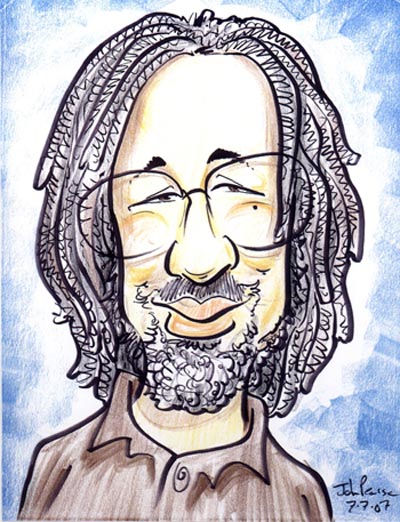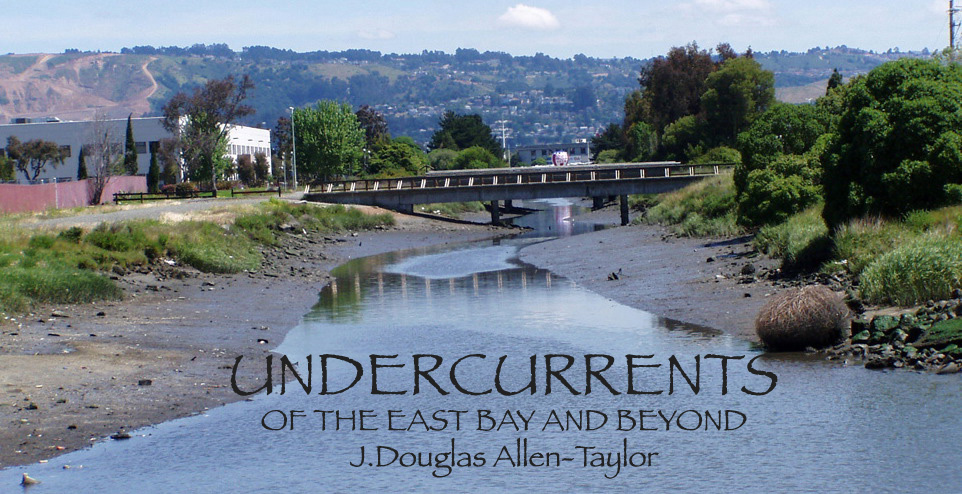|
|
CLEARING OUT THE SAVAGES
October 26 , 2007
Back South where I once lived, I used to know and older man, who I’d greet every time I saw him with the question, “How’s the world treating you?” “The world treating me pretty good,” he’d always answer. “It’s some of them rotten peoples in it, I’m having most of my trouble with.”
It’s an old joke, of course, but in many ways it describes the attitude of some Oakland commentators and policymakers, who seem to approach the city like the old European explorers approached the American shores, dreaming over all the wondrous things they might do with this wondrous new land, if they could only clear out some of the heathen savages wandering around.
And so we have whoever has set up the OaklandSucks blog (they fail to provide a profile to identify themselves further), who writes in a “Oh How We Hate Urban Economics” posting earlier this week (October 23): “Guess what? The residents of West Oakland would rather live in a hyper-crime ghetto than in a nice area, at least that's what everyone found out at a West Oakland Project Area Committee meeting. And honestly, we don't blame them. Why should they be forced to change their lifestyle of drug dealing, aggravated assault, and general theft to accommodate outsiders that want something better? Well, they shouldn't! In fact, the residents of West Oakland believe that their current existence is the way things have always been (failing to realize of course that West Oakland was once 83% white-folk). Therefore, if everything has always been this horrible, new development to try and improve West Oakland is only going to change things, and probably for the worse.”
Ha. And ha.
There is much that is patently incorrect in this bit of anti-Black bigotry, the major one being that it is the poster herself (himself) who appears to make the nexus between drug dealing, aggravated assault, and general theft and a community that is no longer 83 percent white. Long-time Oakland residents themselves remember that two generations back, West Oakland was the anchor of the city’s African-American middle class, the place where “the nicest people lived,” my grandmother used to tell her children, with 7th Street the center of a nationally-renowned African-American social scene that drew visitors from around the area to see the likes of Duke Ellington, Ella Fitzgerald, Ray Charles, and such. When West Oakland residents say they wish to fight gentrification in order to protect and restore their community, my guess is that it is to this golden period they look. Their concern is that if West Oakland is restored to its old grandeur as a series of gated communities where current residents can no longer afford to live, viewing it from a distant height only as they pass along 880 on their way to Vallejo or Antioch, then what is the benefit to most of the current residents?
The thinking that is present in the OaklandSucks post is what fueled a good bit of the development binge during the Jerry Brown years, from the Estuary loft district to the Forest City Uptown project to Oak To Ninth, with the unsubtle goal of developing housing designed specifically to attract people who do not live in Oakland and currently do not consider giving us the time of day. The smelly underside of that policy was a studied neglect of improvement in many of the lower income neighborhoods where the darker people live for the benefit of the people currently living there, along with concurrent efforts to make the city unpopular for les undesirables, slowly and methodically pushing them out. If such twin policies were to succeed, a generation from now Oakland would be a largely whitebread, middle class city, with merely a smattering of color here and there to give it flavor.
There are many such communities ringing the Bay Area, of course, to which so many of my white neighbors fled in the 50’s and 60’s when the greater Oakland neighborhoods began opening up, first to African-Americans, then to Latinos, then to the world. Tired of the long commute, however, the children and grandchildren of those old neighbors now seek to return to the city their families long ago abandoned.
There are some people of dark color—perhaps unknowing of its ultimate consequences, perhaps not, who knows what lurks within the hearts of men?—who are loud advocates of these policies of resettlement.
One of them is former AC Transit Director Clinton Killian, who full disclosure obliges me to reveal once represented, in his capacity as an attorney, the opposite side in a legal matter to which I was a party. That was long ago, and the matter is no longer pending.
In a series of “Killian Analysis” columns in the local Globe newspaper, Mr. Killian has taken on the development policies of Mayor Ron Dellums. Those policies, based in the mayor’s Model City agenda, are quite the opposite of the Jerry Brown Resettlement Doctrine, seeking instead to make the city safer and more economically vibrant for those who currently live here, encouraging all of us to stay.
For reasons of his own, Mr. Killian chooses to attack Mr. Dellums’ Budget Chief, Dan Lindheim, rather than Mr. Dellums himself, although on the surface, at least, the proposals Mr. Killian is objecting to appear to be coming from the mayor rather than his subordinate.
In an October 17 column entitled “Dr. No” (that being the title he gives Mr. Lindheim because he believes Mr. Lindheim is blocking development projects), Mr. Killian writes “Mayor Ron Dellums has consistently stressed his priority to expand and diversify the initial economic revitalization. However, it does not appear that all his staff is fully supportive of his stated goal to rebuild Oakland. His economic development director Dan Lindheim has taken actions that are in clear contradiction of the mayor’s stated policies and the desire of the overwhelming majority of Oakland citizens. … [Lindheim] has become a project killer of the types that the mayor supports and would benefit Oakland.”
The three projects Mr. Killian accuses Mr. Lindheim of specifically blocking are the Mandela-Gateway Project at the old Pacific Pipe site on West Grand and Mandela in West Oakland, the Embarcadero Cove project in the Coliseum development area, and The Transit Gateway project near the Fruitvale Bart station west of International. In each instance, Mr. Killian says that in opposition to both the staff reports and community support, Mr. Lindheim has prevented the development of three projects that would bring needed jobs, housing, and commercial development to West Oakland, Deep East Oakland, and the Fruitvale.
Mr. Killian says that Mr. Lindheim’s views have been improperly influenced by Oakland industrial property owner Robert Schwartz, who he says “has a strong economic and personal connection” with Mr. Lindheim, being “the business partner of Mr. Lindheim’s uncle and cousin.”
“For years,” Mr. Killian writes, Mr. Schwartz “has railed against transforming Oakland’s industrial land. Under Jerry Brown, his views were roundly discredited. Now under Dellums, he has his friend Dr. NO’s [Mr. Lindheim’s] ear. As a result, [Mr. Schwartz] chaired the mayor’s land use taskforce and has strongly pushed the city to a no industrial transformation policy. This opposition is extremely curious and appears to be motivated by blind self-interest and not in the best interest of Oakland citizens.”
Oakland became known in some circles as “money town” during the Brown-and-State-Senator-Don-Perata years, with ongoing accusations and federal investigations that developers gave bribes to local officials and state officials with local ties in order to grease the way for particular developments. We should always take seriously, therefore, any charges that personal gain by city officials rather than community gain may be the real reason behind the approval or disapproval of any particular development.
However, in his column, Mr. Killian fails to show how Mr. Schwartz would personally gain directly from either the retention of the existing industrial lands in Oakland or the denial of the three projects in question (obviously, anyone with industrial development interests might ultimately benefit from retaining Oakland’s industrial land, but that hardly qualifies as improper advocacy).
Further, in talking about the Mandela-Gateway Project, Mr. Killian fails to mention that the first city official to oppose the project was not Mr. Lindheim, or Mr. Dellums, but was the longtime Councilmember representing that district, Nancy Nadel.
In December of last year, before Mr. Dellums took office as mayor, Ms. Nadel told a gathering of a “gentrification bus tour” of West Oakland sponsored by Just Cause Oakland that the proposed Mandela-Gateway posed “a problem of incompatible mixed use. Mandela Parkway is being transformed in a way that is driving out long-term residents. Most of the existing residents don’t have the capital to buy the live-work spaces that are being proposed, or to set up small businesses in the spaces that are being offered.” Mr. Lindheim was one of the listeners at that gathering.
In a later newspaper interview, Ms. Nadel said that industrial zoned land constitutes only 3 percent of Oakland, and that the remaining industrial-zoned acres ought to be treasured and preserved so that industries can be attracted to provide jobs for current Oakland residents.
Meanwhile, that same fall, members of the mayor’s housing task force voted 19-0 (seven members abstaining) to recommend that the mayor’s office “develop and review an industrial land conversion policy to prioritize industrial retention and prioritize rezoned industrial to residential land for affordable housing.”
The Mandela-Gateway developers, in fact, had asked for a change in the zoning of the old Pacific Pipe property from industrial to mixed-use in order to accommodate their project. Last March, the Zoning Update Committee of the Oakland Planning Commission was scheduled to consider that request, but delayed it at the request of the Dellums Administration until an overall look at the General Plan, the zoning ordinances, and the city’s industrial needs can be undertaken. Mr. Dellums has said that he wants a zoning policy that reflects the overall needs of the city rather than a chameleon policy—my words, not the mayor’s—that changes colors and hues depending on the needs of a current developer.
There’s a need to have this discussion on the goals of Oakland development policy—whether it should transform Oakland by clearing out “undesirable” residents and communities, or whether it should serve as a rising lake to lift the boats of everyone currently living in the city. Let’s all of us reveal our agendas, personal and political, so we know where each other stands, and the conversation can move forward without all this rancor and personal attack and slurs against entire communities.
|

